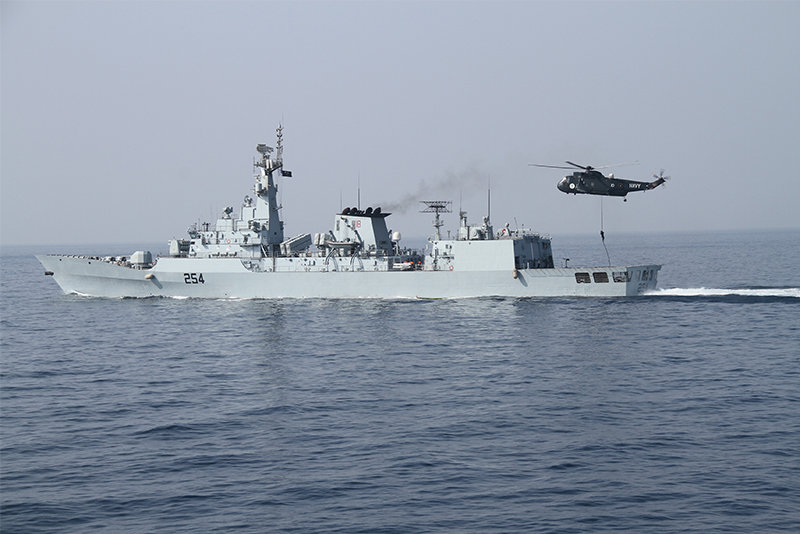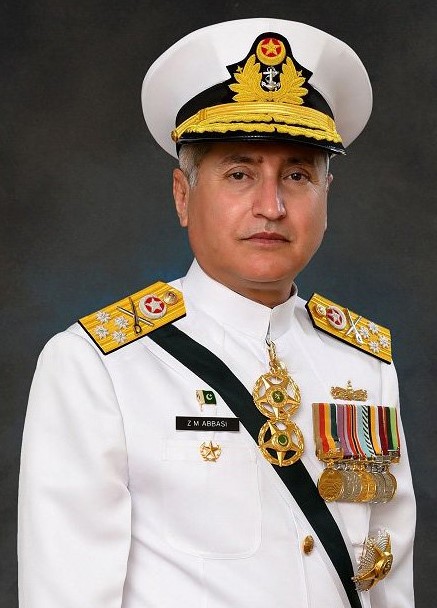Oceans are of crucial value for humanity as they are considered a common heritage and have always shaped civilizations and empires. Waters have provided opportunities to explorers, invaders and traders. After the World Wars international economic dependence increased; mostly through seas. Lately, by employing nuclear missile firing capable submarine and placing aircraft carrier groups at various geo-political manoeuver spaces and choke points in oceans, naval powers have transformed war into deterrence. In consonance with existing facets like ever expanding globalization and global economic inter dependence, oceans have converted diplomacy into ‘Blue Diplomacy’. Being bounded by Asia, Africa, and Australia while housing most of the world population and hydrocarbon reserves, the Indian Ocean is the most vital part of Blue Diplomacy. Interests of naval powers like China in the Indian and Atlantic Oceans and the U.S interests in South China Sea, East China and Australian Seas will further add to economic interdependence and diplomacy. Being strategically located and a nuclear power, Pakistan is a major stakeholder in diplo-economic gains in Indian Ocean Region (IOR) and is playing its role for peace and stability in IOR.
Since the start of decolonisation of Asia after World War II, America has been asserting to dominate the IOR. However the emergence of China as a world economic power is causing’s anxieties to the U.S. In order to contain China, the U.S has announced shifting her naval assests to the Pacific Ocean and is backing its allies like Australia, Indonesia and India to secure the sea lines of communications to safeguard its interets in the Indian Ocean. China’s adoption of ‘Stirngs of Pearls’ strategy to secure its sea lines of communications and construction of Gwadar Port at the gateway of energy distributing choke point of Strait of Hormoz, U.S apprehensions have been about the possible Chinese naval buildup as it can counter American domination of Malacca Straits. Apart from using Gwadar as a pivot, the Chinese have also planned to construct Kara Canal in southern Thailand to link the Bay of Bangal with the South China Sea, hence bypassing the choke point of Malacca which can cause a power struggle in entire Indo-Pacific Region (IPR). Apart from housing bottlenecks like Hormuz, Malacca and Babul Mandab, the Indian Ocean encompasses islands like Comoros, Madagascar, Maldives, Mauritius, Seychelles, Sri Lanka and Diego Garcia with Indonesian archipelago on the eastern flanks; military bases have been established by America and Britain. Its littoral states include, 15 African, 24 Asian, 4 Australia and 2 Oceanic states which mostly are Muslim. Inauguration of the Suez in 1869 invigorated European’s interests in Asiatic Rim land.
The Indian Ocean offers prime SLOCs linking Europe, Middle East, Africa, Asia and the Americas. It provides 40% of petroleum from the Persian Gulf oilfields and Indonesia. Large hydrocarbon reserves from Middle East, Iran and Western Australia combined with energy reserves of Central Asian Republics have reinvigorated the diplo-economic interests. Strategically, Indian Ocean can be divided into three separate regions. Global fuel requirements combined with presence of hydrocarbon reserves and existence of main oil transporting SLOCs between Hormuz and Malacca Strait needs a harmonious IOR. However, primarily safety concerns in IOR depend upon relations among two arch nuclear rivals; India and Pakistan due to various disputes especially Kashmir and Sir Creek. It is in the domain of Indian aspiration for its power projection. Whole water span is vibrant for inclusive security of SLOCs and coastal areas. India is improving its relations with neighbouring littoral and non-littoral states. Peace and stability in the Indian Ocean is pivotal for financial security of India as well.
India needs supporting powers in IOR to counter China for which it seeks the help of U.S. Security of SLOCs. Chinese presence in Myanmar and Coco Island is a concern for India, who is looking for U.S support to deal with Chinese emerging power by monitoring six and ten degree channels. Over 127 conflicts in 2014 indicate the requirement of peace and stability in IOR. Islamabad has always understood the economic and security dimension of IOR and has always tried to play a positive role for peace and stability in IOR.

The Pakistan Navy being cognizant of national maritime concerns has always played a vital role for facets like maritime environment, economic development, national security and human security. Considering the opportunities in the form of CPEC, international laws/ conventions on sea and moral responsibilities, Pakistan Navy is also contributing through international forums on the following aspects.
In 2008, there were 293 piracy incidents which were 263 in 2007. The attacks on USS COLE in 2000 and the French tanker LIMBURG in 2002 off Yemen and the suicide attack on Iraqi oil platforms in April 2004 were clear manifestations of this threat. In April 2009, in two separate incidents, the pirates attacked and hijacked a container ship and a bulk carrier; both the ships were taken to an undisclosed location in Somalia. Conscious of its international obligations Pakistan Navy joined the U.S led coalition ‘Coalition Maritime Campaign Plan’ in 2004 which is the maritime component of ‘Operation Enduring Freedom’ and is intended to keep a check on sea-borne terrorist elements. Pakistan Navy is contributing one ship with embarked helicopters on a regular basis. In recognition of its professional ability and dedication to task, Pakistan Navy was given command of the multi-national task force TF-150 for 10 times. Apart from TF-150, upon adoption of a resolution by UNSC to combat piracy around Horn of Africa and Somali coast, Pakistan Navy has also joined and commanded US led multi-national Task Force-151 and has also commanded this task force for 8 times.
Since 2014, approximately 94,000 people illegally departed by sea from Bangladesh or Myanmar, where 5000 were abandoned by smugglers out of which nearly 1100 died at sea. In 2015, a Combined Maritime Forces (CMF) ship captured 427 Kilogram of heroin in the Indian Ocean, which the CMF called ‘drug haul’. Seas provide safe transportation of arms, ammunition and drugs across the world. Drug trafficking is acknowledged as the second largest lucrative unlawful industry after arms sales. Afghanistan supplies an estimated 93 per cent of the global market of illegal opiates. Traffickers change courses considering aspects like weather, efficacy of law enforcement agencies, and political scenario.
During the 2004 tsunami, Pakistan Navy provided all type of human assistance. Two Pakistan Navy ships visited Maldives and saved 367 foreign tourists representing 17 nationalities. Another group of ships with three embarked helicopters and fifty-four men provided relief goods, food and medical equipment during relief efforts in Sri Lanka and Indonesia. The ships carried an 80-member paramedical team, along with 15 doctors, to establish 50 bed hospitals in Sri Lanka and Indonesia, and elements of an army engineering battalion, for restoring communications infrastructure in the affected areas.
On the diplomatic front the Pakistan Navy also holds international exercises like AMAN series. The exercises are planned with focused objectives which project positive image of Pakistan as a country contributing towards regional peace and stability; consolidate Pakistan Navy’s position in the regional maritime arena, enhancing interoperability with regional and extra regional navies thereby acting as a bridge between the regions. All this displays united resolve against terrorism and crimes in maritime domain.

As the sea lies in the south of country the majority of Pakistani population has not even physically seen the sea which has caused ‘National Sea Blindness’. Timely seaward awareness of the masses especially for the policy makers is a vital necessity. The knowledge about maritime matters will be the first step towards understanding, evaluation and formulation of a pragmatic ‘Pakistan Maritime Policy’. Efforts made by Pakistan Navy in this regard by organising a maiden ‘Maritime Security Workshop’ for the policy makers in Sep 2017 can prove to be beneficial for government and private institutions.
Maritime Domain Awareness and information sharing can be effectively organized in particular under resource constraints. Surveillance technology and tools for data fusion and algorithmic analysis are expensive. Pakistan has inaugurated its Joint Maritime Information Coordination Center (JMICC) which is situated in Karachi and operated by the Pakistani Navy. The center has developed an innovative approach to MDA which can be used as a model for regional countries. JMICC performs in six domains that include maritime terrorism, piracy, organized maritime crimes, illegal exploitation of the EEZ, marine pollution, search and rescue by involving 46 stakeholders. JMICC staff frequently visits coastal community, listens to the concerns and discuss their problems. The goal of the visits is also to promote JMICC as a trustworthy partner and as the first point of contact for reporting suspicious activities and incidents. Once it receives relevant information, discusses it with its stakeholders, and identifies the relevant agencies to initiate a response, it enters the incident information into the Common Operation Picture and compiles an after action report, which is saved in a database and informs future actions. Gradually, JMICC is building up analytical and predictive capacity.
The Pakistan Navy is playing a pragmatic role not only for defence of the motherland but is also endeavoring to improve the maritime security concerns of Pakistan. It is also playing its role to enhance peace and stability in the Indo-Pacific Region.




